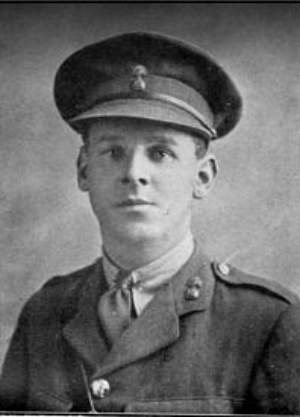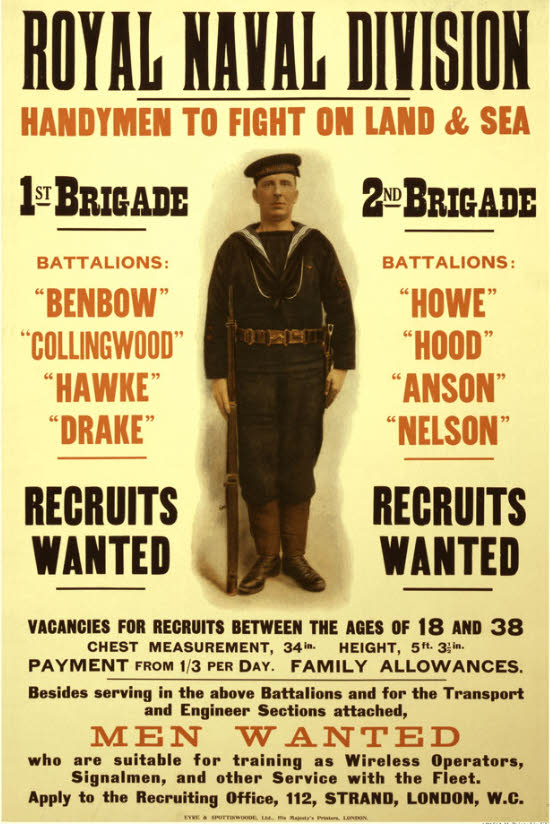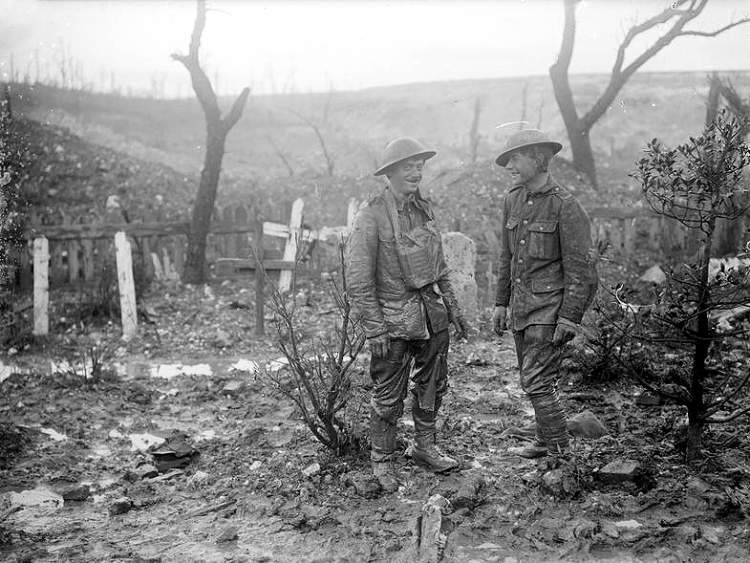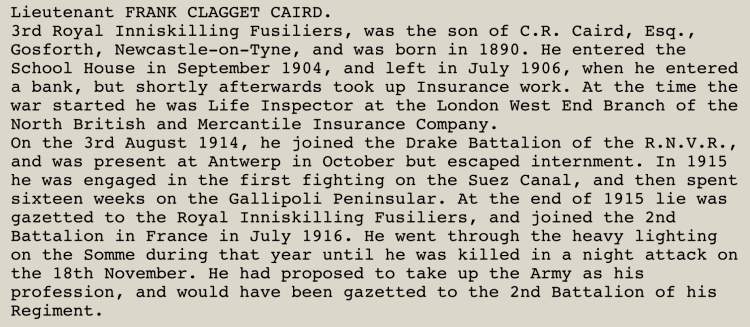 2nd Lieutenant Frank Clagget Caird, 2nd Battalion, Royal Innskilling Fusiliers
2nd Lieutenant Frank Clagget Caird, 2nd Battalion, Royal Innskilling Fusiliers
Frank Clagget Caird was born on the 29th March 1890 in Ossett, the son of Welsh born insurance inspector Charles Randolph Caird and his wife Catherine (nee Woodcock) who had married at Holy Trinity Church, Ossett on the 22nd April 1885. Catherine Woodcock was the daughter of foreman dyer Joshua Woodcock and was born at Silcoates, Wrenthorpe, Wakefield in 1858 and by the mid 1880s, the Woodcock family were living in Dale Street, Ossett. At the time of their marriage, Charles R. Caird, aged 27 years, was living in Leeds, but by 1891 the Caird family were living in Ryecroft Street, Ossett where Frank C. Caird was born.
There were five children from the marriage: Charles Donald Caird b. 1886 in Leeds; Jessie Sybil Caird b. 1887 in Leeds; Frank Clagget Caird b. 1890 in Ossett; Lena Coral Caird b. 1896 Harrogate and Gladys Marjorie Caird b. 1898 in Tynemouth.
By 1901, the Caird family have moved from Ryecroft Street, Ossett to live at 33, Percy Gardens, Tynemouth and Charles Caird is now an Insurance Office Secretary. Percy Gardens is a Victorian crescent of houses situated on the sea front in Tynemouth. The houses overlook the North Sea, the North Pier and Tynemouth Priory.
In September 1904, Frank Clagget Caird attended Durham School, an all boys, fee-charging boarding and day school in the English public school tradition located in Durham. He left in July 1906 to work in banking, before taking up work in the insurance sector like his father. At the time the war started in August 1914, Caird was a Life Insurance Inspector at the Londone Werst End Branch of the North British and Mercantile Insurance Company.
The Caird family have moved again in 1911 and are now living in a nine-roomed house at The Cedars, Forest Hall near Longbenton with two domestic servants, a gardener and a Swiss national governess. Frank Caird, 21 years, is now working in banking. Forest Hall was a large house and estate owned by the Wilson family. Forest Hall with it's medieval tower was demolished in 1962 and the estate developed into the village of Forest Hall.
Caird's service in Drake Battalion, Royal Naval Division
Frank Caird enlisted in "B" Company, Drake Battalion of the R.N.V.R. as an Able Bodied Seaman on the 6th August 1914 and was given the service number 9/3421. His record card shows previous service as a purser on the "Isle" Line and his home address as 29 Thornton Ave, Turnham Green, in West London. His previous occupation was Life Insurance Inspector and he was 5ft 6¾" tall, 33" chest, brown hair and grey eyes.

Whilst serving with the Drake Battalion, Frank Caird was involved in the desperate defence of Antwerp against the invading Germans in September and October 1914, narrowly evading internment in neutral Holland.
Caird was then involved in the Suez offensive when on the 2nd February 1915, Turkish forces in the Middle East attempted to breach British defences on the strategically vital Suez Canal. Seizing it would cut British communications with East Africa, India and Asia, and prevent British Empire troops from reaching the Mediterranean and Europe. The British had expected the offensive and were well prepared, having fortified the length of the canal. The fighting lasted two days with the Turks losing over 2,000 men. British losses were minimal.
After seeing action at the Suez Canal in Egypt. Frank Caird landed in Gallipoli with Drake Battalion on the 26th April 1915 and saw much action against the Turkish Army of the Ottoman Empire. He was admitted to Field Hospital on the 10th August 1915 with Conjunctivitis and then embarked on the Hospital Ship. 'Andania' for England and was admitted to hospital in Plymouth on the 1st September 1915 for treatment on his eyes. On the 1st December 1915 he was sent to the 1st Reserve Battalion at Blandford, Dorset. on the 22nd December 1915 he was discharged and attached to the British Army.
The British Royal Naval Division (RND) was formed at the direction of Winston Churchill, First Lord of the Admiralty, when World War I broke out and was composed primarily of surplus Royal Navy reserves who were not required at sea. It came to be known as "Winston's Little Army."
Although its men enlisted for service as sailors, they were deployed as infantrymen, and saw action in some of the most brutal fighting of the war. Considered elite troops, they retained many seafaring traditions - including palm-down salutes, the wearing of facial hair, and the use of Royal Navy ranks and terminology - much to chagrin of Army commanders.
The RND participated in the defence of Antwerp, fought at Gallipoli and, after being redesignated the 63rd Division in July 1916, served on the Western Front in France for most of the balance of the war, seeing action in numerous major battles including the Somme, Ancre (ironically, French for "anchor") and Passchendaele.
Caird's service as a commissioned officer in the 2nd Battalion, Royal Innskilling Fusiliers
On the 21st January 1916, Frank Caird was appointed as a 2nd Lieutenant (on probation) with the Royal Innskilling Fusiliers (as reported by the London Gazette) and joined the 2nd Battalion in France in July 1916.
At the outbreak of war, the 2nd Battalion, Royal Innskilling Fusiliers were based in Dover with 12th Brigade, 4th Division and landed in France during August 1914. After suffering heavy losses, they moved to Army reserve in December 1914, before being transferred the next month to 5th Brigade, 2nd Division. In July 1915, the battalion was moved to Army reserve and, by the end of the year, had transferred to 14th Brigade, 5th Division and then onto to 96th Brigade, 32nd Division. In February 1918, they transferred to 109th Brigade, 36th (Ulster) Division.

Above: Soldiers at Beaumont Hamel in November 1916.
The War Diary for the 2nd Battalion, Royal Innskilling Fusilers1 gives more background on the death of Lieutenant Frank C. Caird during his time in the trenches around Beaumont Hamel:
"18th November 1916
About 4pm the Battalion proceeded to the front line near BEAUMONT HAMEL and relieved the 16th H.L.I. in the line
18-24th November Battalion remained in the front line."
After an abortive raid on MUNICH TRENCH the 23rd November with many casualties, the War Diary on the 24th November has this entry:
"Battalion relieved by the 1st South Staffs, 91st Infantry Brigade, 7th Division and withdrew to billets in MAILLY MAILLET. Casualties during the tour in the trenches (not including attack on the 23rd). Wounded 2nd Lieutenant F.C. Caird (died of wounds) and 2nd Lieutenant J.F.W. Reid. Other ranks: Killed 6, Wounded 40 and Missing 5."
2nd Lieutenant Frank Clagget Caird died from wounds on the 22nd November 1916 and is buried in Puchevillers British Cemetery at position III. B. 9. Puchevillers is a village on the D11 about 19 kilometres north-east of Amiens. The British Cemetery is a little west of the village. The first Commonwealth War Graves Commission signpost is situated by the church in the village.
In June 1916, just before the opening of the Battles of the Somme, the 3rd and 44th Casualty Clearing Stations came to Puchevillers. Plots I to V, and almost the whole of Plot VI were made by those hospitals before the end of March 1917.

Above: The obituary for Frank Clagget Caird in the WW1 Book of Remembrance at Durham School.
Frank Clagget Caird is remembered on the war memorial in the chapel at Durham School, its walls are engraved with the names of those who died in World War I and the further 79 who died in World War II. There are 97 steps to the chapel, one for each of the Old Dunelmians who died in World War One.
Frank Clagget Caird's name was quietly added to the Ossett War Memorial with little or no notice in October 2023.
References:
1. 1916 War Diary for the 2nd Battalion, Royal Inniskilling Fusiliers.
2. Ancestry Family Trees for Frank Clagget Caird.
3. North East War Memorials Project